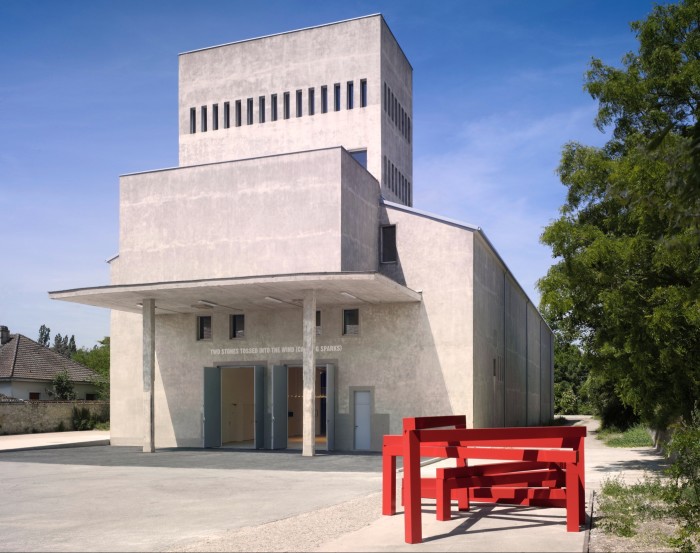Collectors Jean-Philippe and Françoise Billarant have maxed out on Minimalism

Unlock the Editor’s Digest for free
Roula Khalaf, Editor of the FT, selects her favourite stories in this weekly newsletter.
“This is our happiness, our joy!” exclaims Françoise Billarant, when I ask her if running a private museum with her husband Jean-Philippe is very demanding.
The couple are in their early eighties, and for almost half a century they have focused exclusively on collecting Minimalist, conceptual and contemporary art. In 2011 they opened Le Silo, a private art space in a former grain storage in a small town 45km north-west of Paris, to show their extensive collection.
The Billarants’ money comes from the family company Aplix, a maker of hook-and-loop fasteners with 880 global employees and a turnover of a little under €200mn. Today, their daughter Sandrine is chief executive, the third generation in the business.

Neither Françoise nor Jean-Philippe’s families were art collectors, they tell me as we drive back from Le Silo. The couple started buying art in the mid-1970s, traditional paintings at the Parisian saleroom Drouot, “just to put something on our walls”, says Jean-Philippe. Their initial enthusiasm for this older art soon waned. He explains: “I thought there must be contemporary artists who will be as significant one day as the Old Masters are now — with the advantage that we can get to know them.” A first foray into contemporary art, the purchase of two pretty pastoral scenes from a Right Bank gallery, ended with them taking them back to the dealer: “They were very pretty — too pretty,” Jean-Philippe laughs.
A turning point was a dinner with the curator Suzanne Pagé, at the time with the Musée d’Art Moderne de la Ville de Paris, and a later meeting with Serge Lemoine, former president of the Musée d’Orsay and a specialist in geometric abstraction. “Gradually, we moved towards conceptual and minimal art. We really taught ourselves. And we bought with our eyes, not our ears,” Françoise says. Jean-Philippe interjects: “Initially we didn’t buy with the idea of forming a collection, it was our way of supporting the artists. But we couldn’t leave the works in crates, so to give them life, we had to put them on display.”

For 30 years they were thinking of showing the collection, but when they had the “time and money” it only took a year to find Le Silo. About 100-120 works are displayed at a time in the building, and every two years the exhibition is changed; Jean-Philippe curates each show. “We have held seven to date, but we still haven’t been able to show everything,” says Françoise. Their Parisian home also shows Minimalist art, “but on a smaller scale”, she says.
Le Silo is open by appointment only; during Art Basel Paris the Billarants are expecting dozens of visitors, whom they take round themselves, communicating their enthusiasm for each piece. The sizeable collection, which numbers just under 1,000 works, is very much a mutual passion, and both know it intimately. There seems to be a great affinity between them, and they correct each other good-naturedly if the other hesitates over, say, a date.


“We know, or knew, almost all the artists we collect — they became friends,” says Jean-Philippe. The collection starts in the 1960s and comprises pieces by the great names of Minimalism — a copper floor piece by Carl Andre (“Mons Veneris”, 1975), two metal boxes by Donald Judd (1969), a wall drawing by Sol LeWitt, a neon by Dan Flavin, as well as newer names — French artists François Morellet, Daniel Buren and the Scottish artist Charles Sandison, with wall pieces made of metal plaques. Also in the collection is “Proposition” (2002), a white-and-black work by the Brazilian couple Angela Detanico and Rafael Lain, who are among the contenders for the Prix Marcel Duchamp (the French equivalent of the UK’s Turner Prize) this year.
These and many more are displayed in the buff-coloured building, which dates from 1962 and was converted by the architect Dominique Perrault. A Lawrence Weiner text stands above the two doors — “Two Stones Tossed into the Wind (Causing Sparks)” (1988) — which open into a light-filled, airy space with the works carefully spaced out. Propped against one wall are two rusted metal squares by Richard Serra (“Basic Source”, 1987). “They weigh 1.7 tonnes . . . so they are never moved,” says Jean-Philippe.

Delicately, I ask what the future of Le Silo is. “We have a project which will enable it to remain after we have gone,” says Jean-Philippe. “I can’t tell you more, but there will be an announcement within the year.” I try to guess: a deal with the French state? Tantalisingly, they remain tight-lipped.
As our visit comes to an end, Françoise says, “Time is essential, to build a collection like this.” And we can only hope that it will last into the future, well beyond their own lifetimes.
Le Silo: route de Breancon, 95640 Marines. +331 4321 3816, by appointment only
#Collectors #JeanPhilippe #Françoise #Billarant #maxed #Minimalism





